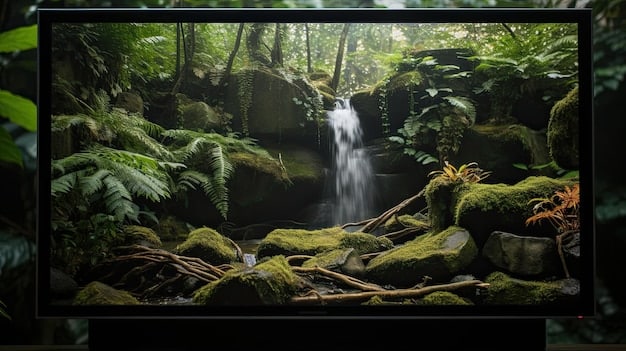Unlocking 4K Streaming: Your 2025 Guide to Ultra HD in the US

Anúncios
Unlocking 4K streaming in 2025 involves understanding bandwidth requirements, choosing compatible devices and streaming services, and optimizing your home network to fully enjoy the immersive Ultra HD experience available to viewers in the US.
Anúncios
Ready to witness visuals like never before? This guide to Unlocking 4K streaming in 2025 will equip you with the knowledge to navigate the world of Ultra HD content and ensure you’re getting the most out of your viewing experience in the US.
Understanding 4K Streaming: What You Need to Know
As 4K content becomes increasingly prevalent, understanding the technology behind it is essential. Before diving into specific streaming platforms or hardware, let’s explore the fundamental aspects of 4K and Ultra HD.
Anúncios
4K, often referred to as Ultra HD (UHD), represents a significant leap in resolution compared to traditional HD. This means a sharper, more detailed picture, bringing your favorite movies and shows to life.
The Resolution Revolution: 4K vs. HD
The jump from HD to 4K is more than just a slight improvement; it’s a complete overhaul of visual fidelity. Here’s a breakdown:
- Pixel Count: 4K boasts roughly four times the number of pixels as 1080p HD, translating to a vastly more detailed image.
- Image Clarity: With more pixels packed into the same screen size, 4K delivers superior clarity and sharpness.
- Immersion: The enhanced detail creates a more immersive viewing experience, drawing you deeper into the content.
To fully embrace the 4K revolution, you’ll need compatible equipment, including a 4K TV or projector and a streaming device capable of outputting 4K video. Keep reading to discover tips for evaluating device compatibility.

Essential Equipment for 4K Streaming in 2025
Having the right equipment is crucial for a seamless 4K streaming experience in 2025. It’s not just about having a 4K TV; you’ll also need a streaming device that can handle Ultra HD content, as well as a robust internet connection.
Selecting the proper equipment involves considering factors like compatibility, processing power, and HDR support. Here are some key aspects to consider when upgrading your setup for 4K streaming.
Choosing the Right 4K Streaming Device
The market is flooded with streaming devices, but not all of them are created equal when it comes to 4K. Consider these factors:
- Processing Power: Ensure the device has sufficient processing power to decode and output 4K video smoothly.
- HDR Support: High Dynamic Range (HDR) enhances color and contrast; look for devices that support HDR10 or Dolby Vision.
- Connectivity: A stable Wi-Fi connection or Ethernet port is crucial for uninterrupted streaming.
Beyond the hardware, also consider the user interface and app availability of different streaming devices. Popular options include Roku, Amazon Fire TV, Apple TV, and Chromecast with Google TV. These platforms offer a variety of 4K streaming apps and services.
Optimizing Your Internet Connection for 4K
One of the most common bottlenecks in the 4K streaming experience isn’t your TV or streaming device, but your internet connection. 4K video requires a significant amount of bandwidth to stream smoothly, and a slow or unstable connection can lead to buffering, stuttering, or a reduction in video quality.
To ensure a reliable 4K streaming experience, understanding bandwidth requirements and network optimization is crucial.

Bandwidth Needs for 4K Streaming
The amount of bandwidth required for 4K streaming can vary depending on the service and content, but here’s a general guideline:
- Minimum Requirement: Most streaming services recommend at least 25 Mbps for 4K streaming.
- Optimal Performance: For a smoother and more reliable experience, aim for 50 Mbps or higher.
- Multiple Devices: If you have multiple devices streaming 4K content simultaneously, you’ll need even more bandwidth.
In addition to raw bandwidth, factors like network congestion and latency can also impact streaming performance. These tips can improve your internet connection:
- Use Ethernet: Connect your streaming device directly to your router via Ethernet for a more stable connection.
- Upgrade Your Router: An older router may not be able to handle the demands of 4K streaming. Consider upgrading to a newer model with better performance and range.
- Minimize Network Congestion: Limit the number of devices using your internet connection while streaming 4K content.
Navigating 4K Streaming Services in the US
With the hardware and network aspects covered, it’s time to explore the wide variety of 4K streaming services available in the US. From established giants like Netflix and Amazon Prime Video to niche platforms offering specialized content, there’s a 4K streaming service for everyone.
Each service has its own library of 4K content, subscription price, and unique features. Finding the right combination of services can enhance your viewing experience.
Comparing Popular 4K Streaming Platforms
Let’s take a look at some of the leading 4K streaming services in the US:
- Netflix: Offers a wide selection of 4K movies, TV shows, and original content. A premium subscription is required for 4K streaming.
- Amazon Prime Video: Includes a growing library of 4K content, including original series and movies. 4K streaming is typically included with an Amazon Prime membership.
- Disney+: Home to a vast collection of 4K Disney, Pixar, Marvel, Star Wars, and National Geographic content. 4K streaming is included with a standard subscription.
Beyond these major players, other streaming services like HBO Max, Hulu, and Apple TV+ also offer 4K content. It’s worth researching each service’s library and subscription options to determine which best fits your viewing preferences and budget.
Understanding HDR and Dolby Vision for Enhanced 4K
While 4K resolution provides a significant leap in detail and clarity, High Dynamic Range (HDR) takes the visual experience a step further. HDR and its advanced form, Dolby Vision, enhance color, contrast, and brightness, creating a more lifelike and immersive image.
Understanding the benefits and requirements of HDR and Dolby Vision is essential for maximizing your 4K viewing pleasure.
The Benefits of HDR and Dolby Vision
HDR and Dolby Vision offer several key improvements over standard dynamic range (SDR):
- Wider Color Gamut: HDR expands the range of colors that can be displayed, resulting in richer, more vibrant visuals.
- Increased Contrast: HDR increases the contrast ratio, allowing for deeper blacks and brighter whites, adding depth and realism to the image.
- Enhanced Brightness: HDR can increase the peak brightness of the display, making highlights pop and enhancing overall clarity.
To experience HDR and Dolby Vision, you’ll need a compatible TV or projector, a streaming device that supports HDR output, and content mastered in HDR. Many 4K streaming services offer HDR content, but it’s essential to verify compatibility before streaming.
Troubleshooting Common 4K Streaming Issues
Even with the right equipment and a stable internet connection, you may still encounter occasional issues while streaming 4K content. Understanding common problems and their solutions can save you from frustration and ensure a seamless viewing experience.
Here are some common issues and how to address them:
Common 4K Streaming Problems and Solutions
Here are specific troubleshooting steps you can take:
- Buffering: Buffering is often caused by a slow or unstable internet connection. Try restarting your router, reducing network congestion, or upgrading your internet plan.
- Choppy Playback: Choppy playback can be due to insufficient processing power on your streaming device or outdated software. Try closing other apps, updating your device’s software, or upgrading to a more powerful streaming device.
- Color Problems: Issues with colors can be caused by incorrect HDR settings or compatibility issues. Make sure your TV and streaming device both support HDR, and that HDR is enabled in the settings.
With these fixes in mind, you can handle nearly any issue with your content.
The Future of 4K Streaming and Beyond
As we look towards 2025 and beyond, the landscape of 4K streaming will continue to evolve. New technologies, improved infrastructure, and changing consumer habits will shape the future of Ultra HD content delivery.
Let’s take a peek at some of the key trends and developments that are likely to impact 4K streaming in the years to come.
Emerging Trends in 4K and Ultra HD
Keep up with these innovations in the world of 4K:
- 8K Adoption: While 4K is now mainstream, 8K resolution is beginning to emerge as the next frontier. 8K offers even greater detail and clarity, but it requires significantly more bandwidth and processing power.
- Advanced Codecs: New video codecs like AV1 are designed to deliver higher quality video at lower bitrates, which can improve the streaming experience for users with limited bandwidth.
- Interactive Streaming: Interactive streaming technologies allow viewers to engage with content in new ways, such as choosing different camera angles, accessing additional information, or participating in live polls and quizzes.
| Key Point | Brief Description |
|---|---|
| 📺 4K Resolution | Offers four times the pixels of 1080p HD for sharper images. |
| 🌐 Internet Speed | Requires at least 25 Mbps, ideally 50 Mbps or more for smooth streaming. |
| 🌈 HDR & Dolby Vision | Enhance color, contrast, and brightness for a more vibrant viewing experience. |
| 🛠️ Troubleshooting | Address buffering with a stronger connection and ensure device compatibility. |
Frequently Asked Questions
For reliable 4K streaming, a minimum of 25 Mbps is required, but 50 Mbps or higher is recommended for a smoother experience. If multiple devices are streaming, even more bandwidth may be needed.
Yes, you will need an HDMI 2.0 or later cable to support 4K resolution at 60Hz with HDR. Older HDMI cables may not have enough bandwidth for higher resolutions and frame rates.
To stream 4K on Netflix, you need a 4K-compatible TV, a streaming device that supports 4K, and a Netflix Premium plan. Ensure your streaming quality is set to “High” in your Netflix account settings.
Both HDR and Dolby Vision enhance color and contrast, but Dolby Vision is a more advanced format with dynamic metadata, enabling scene-by-scene optimization for improved picture quality on compatible TVs.
Frequent buffering can be due to a slow internet connection, network congestion, or outdated streaming device. Try restarting your router, using a wired connection, or upgrading your streaming device for smoother playback.
Conclusion
Unlocking 4K streaming in 2025 involves understanding resolution, bandwidth, and hardware. By optimizing your setup and selecting the right streaming services and devices, you can ensure an immersive and visually stunning entertainment experience from the comfort of your home.





